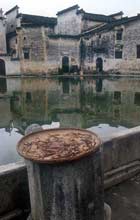 From 1120 in the Northern Song dynasty to the fall of the Qing dynasty in 1911, Huangshan was located in what was known as the Huizhou prefecture.
From 1120 in the Northern Song dynasty to the fall of the Qing dynasty in 1911, Huangshan was located in what was known as the Huizhou prefecture.
Devotees of the "The Romance of the Three Kingdoms", a Chinese historical fiction that describes the warring period from 220-280 A.D., will be thrilled to learn that a former residence of General Caocao is located in Huizhou, and that near to it, nine Cao family tombs have been discovered.
Notwithstanding this third century claim to fame, it was not until the middle of the Southern Song dynasty (1127 – 1279) that Huizhou took up a national position that it was to expand over the next 600 years. Under Emperor Gao Zong (r. 1127 – 1187), the Imperial court plumbed new levels of decadence. It reacted to the threat of a Jurchen invasion by relocating the Imperial capital to Hangzhou and initiating an extensive public works program. When the Imperial court arrived at its new capital in 1132, Huizhou merchants were on hand to supply bamboo, wood, lacquer and craftsmen for the construction of palaces, pavilions, villas and temples.
This construction boom provided Huizhou traders with capital to branch out into new industries and provinces. It transpired that with the strengthening of the southern economy, Huizhou's location between Zhejiang and Jiangsu provinces could be made to turn a profit. Soon Huizhou had become a key communications and trade route; local traders diversified into selling tea, grain, silk, cloth, paint, pottery, ink and paper. Commerce, frowned upon in Confucian ethics, became such a boon to this hitherto marginalized area that during Emperor Jiajing's reign (r. 1522 – 1567), some 70% of Huizhou's population was involved in it.
However, it was when Huizhou's merchants turned to the high margin salt and pawnbroking businesses that they were able to accelerate their expansion. They thus spread to all corners of China and even expanded into some Southeast Asian countries. Indeed, it was said that by the reign of Emperor Guangxi (1875 – 1909) all pawnbrokers were from Huizhou.
By investing in Huizhou's education they were able to field many candidates for Imperial Examinations and thus influence the Imperial bureaucracy. Between 960 – 1911 as many as 2,018 people from Huizhou achieved the highest level in Imperial government. In this way, these artful traders conspired to maintain such commercial advantages as their valuable salt monopolies.
Having gained fame and fortune, Huizhou merchants returned to their homeland to invest their gains in large-scale construction. To increase their personal prestige, to honor their ancestors and to strengthen their clan they built ancestral halls, mansions, memorial arches and bridges; all the architectural splendor that still decorate Huizhou's magnificent land.
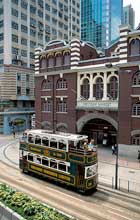 The Special Administrative Region (SAR) of Hong Kong has a population of around 7 million. The SAR is comprised of the island of Hong Kong, the Kowloon Peninsula, the New Territories, which abut China proper, and more than 200 islands, ranging from Lantau Island which is bigger than the island of Hong Kong, to small outcrops in the surrounding seas; the total area is a little over a thousand square kilometers, so it would fit neatly into the city of Los Angeles. Centuries ago, this small parcel of land in the tropics, on the distant margins of the great Chinese empire, was little more than a rocky outcrop. Were it not for the incursions of foreigners, Hong Kong today could be but one of many sleepy fishing villages on the edge of the South China Sea . Instead, first the Mongols and then especially the British, have ensured Hong Kong 's place in history. For the better part of two centuries it has served as the gateway to China , and to this day remains a looking glass through which westerners can catch a glimpse of China , and Chinese a glimpse of the west.
The Special Administrative Region (SAR) of Hong Kong has a population of around 7 million. The SAR is comprised of the island of Hong Kong, the Kowloon Peninsula, the New Territories, which abut China proper, and more than 200 islands, ranging from Lantau Island which is bigger than the island of Hong Kong, to small outcrops in the surrounding seas; the total area is a little over a thousand square kilometers, so it would fit neatly into the city of Los Angeles. Centuries ago, this small parcel of land in the tropics, on the distant margins of the great Chinese empire, was little more than a rocky outcrop. Were it not for the incursions of foreigners, Hong Kong today could be but one of many sleepy fishing villages on the edge of the South China Sea . Instead, first the Mongols and then especially the British, have ensured Hong Kong 's place in history. For the better part of two centuries it has served as the gateway to China , and to this day remains a looking glass through which westerners can catch a glimpse of China , and Chinese a glimpse of the west.
The first, thirteenth-century, irruption was short indeed. At that time the rump of the Southern Song dynasty court had fled south, away from the advancing Mongol armies. Initially they decamped to Silvermine Bay , a part of the old fishing village of Mui Wo , on Lantau Island , before making the Kowloon Peninsula their base. The Southern Song was soon defeated by the Mongols, and Hong Kong 's first brush with empire-wide politics was forgotten. History, however, was not finished with the settlement. In the early nineteenth-century, around the time of the first Opium War, Hong Kong appeared in a substantial way on the historical horizon. The protagonist was Charles Elliot, the British Superintendent of Trade. In response to British merchants being expelled from Macao , Elliot made the island of Hong Kong their base. The Opium War broke out, the Chinese side soon sued for peace and the island was ceded, in perpetuity to the British according to the terms of the Treaty of Nanking in 1842. The Second Opium War also ended in Chinese defeat, and this time the lower end of the Kowloon Peninsula became British territory. Finally, in 1898, the adjacent lands of the New Territories were leased by Britain for 99 years.
Hong Kong muddled along, sometimes serving as a base for revolutionaries such as Sun Yat-sen. Ironically it was the Communist victory on the mainland in 1949 and UN-backed trade embargo that gave Hong Kong the spur it needed to develop as a capitalist haven with a strong manufacturing base specializing initially in textiles. But you'll be hard pressed to find all those manufacturing sweat shops these days – manufacturing now accounts for less than 5% of Hong Kong 's GDP, while the service industry accounts for more than 85%. The entrepreneurial spirit in Hong Kong remains a common thread stringing together the nineteenth-century small business ventures to the early manufacturing enterprises to the present-day service industries. Hong Kong 's foremost Western commentator, Jan Morris described it thus:
"They are opportunists of genius. When communal lavatories were first installed in Hong Kong, Chinese entrepreneurs took to sitting on them for so long that people were obliged to bribe them to come off. When during the plague of 1900 the Government offered two cents for every dead rat delivered to the authorities, there was a brisk flow of imported rodents from the mainland. Marine Department employees posted to the signal station on the otherwise uninhabited Green Island took to breeding goats as a sideline. "(1)
The Communist victory also saw many cultural figures arrive in Hong Kong and they augmented the natural cultural growth that accompanied the economic rise of the colony. Perhaps it is the Hong Kong film industry that is best known in the West and Jackie Chan is now a household name; but other figures not known outside Chinese cultural circles also made the move south, including everyone from martial arts masters to calligraphers. This ensured that Hong Kong developed an organic cultural world together with the cosmopolitan profile left by its colonial past. While 95% of the population is listed as being of Chinese descent, one in fourteen people holds a foreign passport. This latter fact is testament to the international character of much of the population, as well as to the flurry of uncertainty that gripped the population before the handover back to mainland Chinese control, when many citizens felt safer having an alternative in case the new regime turned sour.
These days Hong Kong is no longer the shopping paradise it once was – though some electronics remain good buys. An interesting spectacle if you're browsing is to watch the high end sales. Many of the shoppers for brand-name products are the nouveau riche from mainland China – tired of the perpetual concerns over authenticity in China they believe that purchases in Hong Kong are much less likely to be fake. Funnily enough, even the quality of Hong Kong 's fakes is acknowledged, and street sellers may try to convince you by advertising 'genuine copies'. If you want to spend time on local favourites, then head for the Racetrack at Happy Valley , surrounded by high-rise buildings, and enjoy the night races in the comfort of the Hong Kong Jockey Club.
(1).Jan Morris, Hong Kong: Epilogue to an Empire (London: Penguin, 1997), p.180.
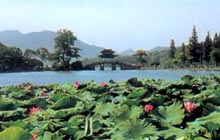 The Western view:
The Western view:
"Green mountains surround on all sides the still waters of the lake. Pavilions and towers in hues of gold and azure rise here and there. One would say a landscape composed by a painter. Only towards the east, where there are no hills, does the land open out, and there sparkle, like fishes' scales, the bright coloured tiles of a thousand roofs."
(Jacques Gernet, Daily life in China on the Eve of the Mongol Invasion)
The Eastern view:
"In heaven there is Paradise, On earth there are Suzhou and Hangzhou." (popular saying)
Hangzhou's inordinate beauty has been an inspiration to artists for centuries – Lin Hejiang, a tenth century poet is famous for having lived as a recluse on Solitary island for twenty years. And indeed, two more of China's most influential poets, Bai Juyi and Su Dongpo, served as governors here at that time.
During the Qing dynasty (1644-1911) the city became known as a popular tourist destination, much frequented by such notables as the Emperor Kangxi and Emperor Qianlong, who built a palace and important library here. Similarly, during the late twentieth century, Mao Ze Dong was smitten by its charm. He snatched moments from his hectic political life to write "Ode to the Mume Blossom", which by its very title recalls Lin Heijiang's "To the Mume Blossom", written a thousand years earlier.
Hangzhou rose to prominence as the capital of the Southern Song dynasty (1127-1279). Forced to flee before the invading Jurched, the Imperial court under the rule of the pusillanimous Emperor Gaozong (1107-1187) moved its capital southwards from Kaifeng to Hangzhou. Under the patronage of this court, Hangzhou's arts and commerce received unprecedented impetus, transforming it, in Marco Polo's words into, "a city of heaven…the finest and most splendid city in the world."
Chinese products, such as silk and ceramics, were traded for wood, pearls and handicrafts from Japan; ginseng and medicinal herbs from Korea; and spices, ivory and jewels from Southeast Asia and the Middle East. As a result, by the end of the thirteenth century, the wealthy population had swelled from half a million to nearly two million. The city became known for its sybaritic life: one resident had the floor of his house covered with tiles inlaid with silver; pets were dyed pink with balsam leaves and Hangzhou's West Lake became the focus of a thirteenth century pleasure-ground with splendid boats, restaurants and entertainers.
Seven hundred years later, Hangzhou's West Lake continues to draw foreign tourists and local Chinese to its beautiful shores.
The Nan mountains, dividing the Yangzi river basin to the north from the Xi river valley to the south, have always protected Guangxi province from unwelcome intruders. They not only shelter this tropical region from the cruelly bitter winds of the Gobi, throughout its history they’ve also shielded it from the encroachments of the Imperialist Han Empire.
From their first invasion here in the 3rd century BC until the 12th century AD, the Han Chinese considered Guangxi an exotic region inhabited by barbaric and unruly aboriginal tribes. From the Yuan dynasty (1271) onwards Imperial control was only successfully maintained by the use of force. Even today, this region, which hosts 12 different ethnic minorities, boasts a fair measure of independence. It is officially known as Guangxi Zhuang Autonomous Region – its largest ethnic minority is comprised of Zhuang people.
Guilin – Capital of Guangxi Province
The construction of the Ling Canal in the 3rd century B.C.E. made it possible for small craft to pass from the Yangzi river to the southward Xi river. Guilin, named after the scent of the local sweet osmanthus trees, was established in the 1st century B.C.E. on the west bank of the Kuei River, which linked the Ling Canal to the Xi River. It grew into an important trading post on the route between central China and the southern ports of Guangdong (Canton), so that under the Ming dynasty (1368-1644) a garrison was set up here. During this period, a policy of “civilizing” military colonization promoted agricultural production in Guilin’s surrounding fertile valleys.
From this time until 1949, Guilin was primarily a handicraft and agricultural center. Under Communist rule however, when industry was promoted in inland areas, factories were built here for the manufacture of chemicals, engineering, paper and agricultural equipment. Nowadays, high transport costs are driving such industries to locations on China’s more accessible Eastern coast. Forced to adapt to the regulation of market forces, Guilin is encouraging tourism and food processing in their stead.
Yangshuo
Situated 65 kilometers (40 miles) east of Guilin, Yangshuo is an ancient town that was declared a county seat during the Jin dynasty some 1,500 years ago. Nestling amidst spectacular limestone spires and towers, it has long been recognized as a wonderful retreat to enjoy Guangxi’s karst scenery. For as many generations, it has also been known for its abundant produce – particularly its oranges, tangerines, pomelos (a relative of the grapefruit), chestnuts and persimmons.
 Through China's long history three geographic areas have been vital to her overall defense. The first is the Tarim Basin, marked on many Western maps as the western half of the Gobi Desert. The second is the marshy grasslands of the Ordos, located around the great loop of the Yellow River, now in Inner Mongolia. The third area is the Orkhon river valley northwest of the Ordos in Outer Mongolia. Whoever controlled any of these three areas had a strong base from which to threaten China. The history of Dunhuang is rooted in China's attempts to defend her western border against threats from the Tarim basin.
Through China's long history three geographic areas have been vital to her overall defense. The first is the Tarim Basin, marked on many Western maps as the western half of the Gobi Desert. The second is the marshy grasslands of the Ordos, located around the great loop of the Yellow River, now in Inner Mongolia. The third area is the Orkhon river valley northwest of the Ordos in Outer Mongolia. Whoever controlled any of these three areas had a strong base from which to threaten China. The history of Dunhuang is rooted in China's attempts to defend her western border against threats from the Tarim basin.
From as early as the seventh century B.C.E., Chinese kingdoms built walls along their northern frontiers to defend themselves against the forays of savage Hun (Xiongnu) nomadic tribes. In 120 B.C.E., during the reign of Emperor Wu (147-87 B.C.E.) of the Western Han dynasty, the most comprehensive Great Wall project to date was initiated, with up to four systems of fortification spanning the breadth of China from Dunhuang in the west to the Korean peninsula in the east. Part of this Great Wall was constructed across the mouth of the Hexi Corridor from Dunhuang's Yumenguan (Jade Gate Pass) in the west to Jiayuguan, 180 miles to the east. Three years later in 117 B.C.E., Dunhuang was appointed a prefecture. For the next millennium, it remained one of China's most important command posts with heavy concentrations of military and civilian personnel.
Since the Hexi Corridor, a desert plain enclosed by two sets of mountains, links the eastern edge of the Tarim basin to China's heartland, Dunhuang's military significance as China's first line of defense from a western attack is clear. Indeed, "Dunhuang" itself means "Blazing Beacon" and refers to a series of beacons – 70 of which remain to this day – used to communicate news of enemy movements to military authorities in the east.
With the rise of the Silk Road and its resultant commerce in trade and ideas, Dunhuang's role and character altered. Though its importance as a garrison remained, it now doubled as a trading post and cultural center. Many cultural relics testify to its wealth and power as a trading area. For example, paper dating back to 94 B.C.E., 170 years before it was previously thought to have been invented, has recently been found here. There can be no greater testament to its cultural significance than the nearby Mogao Caves , Yulin Caves and the Western Thousand Buddha Caves.
From its inception to the end of the Tang dynasty (618-907 C.E.), Dunhuang remained an important center in China's political, economic and military life. However, when China's capital moved eastwards from Xi'an – out of the threatening purview of the Tarim basin – as commerce transferred from land to sea routes, so did Dunhuang gradually lose its national significance.
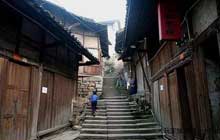 Chengdu , in western China , is the capital of Sichuan Province (former spellings included Szechwan and Szechuan ). The province is known throughout China and the world, for its spicy food, pandas, tea drinking habits, and hot pot. The basin in which Chengdu sits is surrounded by a ring of mountains that formed a natural obstacle to traders and attackers for centuries. For many years the most accessible route into the Sichuan Basin was to brave the perilous shoals of the Yangzi River . Even during the Tang dynasty it was still such a hazardous journey that one of the most famous of Chinese poems from that period begins: "The road to Shu is hard" – Shu being the name of an old kingdom whose capital was Chengdu. This relative isolation from the rest of the Chinese world has meant that at times the Sichuanese have had independent kingdoms, and sometimes their cultural affiliations have been stronger with their neighbours outside the borders of the Chinese world than with the Chinese world itself. To this day the rest of China recognises the special characteristics of the region, and the Sichuanese people are regarded as relaxed and friendly.
Chengdu , in western China , is the capital of Sichuan Province (former spellings included Szechwan and Szechuan ). The province is known throughout China and the world, for its spicy food, pandas, tea drinking habits, and hot pot. The basin in which Chengdu sits is surrounded by a ring of mountains that formed a natural obstacle to traders and attackers for centuries. For many years the most accessible route into the Sichuan Basin was to brave the perilous shoals of the Yangzi River . Even during the Tang dynasty it was still such a hazardous journey that one of the most famous of Chinese poems from that period begins: "The road to Shu is hard" – Shu being the name of an old kingdom whose capital was Chengdu. This relative isolation from the rest of the Chinese world has meant that at times the Sichuanese have had independent kingdoms, and sometimes their cultural affiliations have been stronger with their neighbours outside the borders of the Chinese world than with the Chinese world itself. To this day the rest of China recognises the special characteristics of the region, and the Sichuanese people are regarded as relaxed and friendly.
Chengdu has had a poetic history, known sometimes as the ' Brocade City ' for an official who was in charge of that industry in the city, and also as ' Hibiscus City '. It is famous in the Chinese imagination for serving as the capital of one of the three states that made up the Three Kingdoms Period (222-263), and thus it features strongly in the most famous Chinese political drama ever told, the Romance of the Three Kingdoms . The allure of Chengdu was such that the two most famous Chinese poets both called it home for some time. The province was also the birthplace for the invention of paper money, and in recent years, reprising its independent character, it was the last major city in China to hold out against the Communists.
Once characterized by wooden buildings and teahouses, it has witnessed the same vicissitudes that nearly every other major city in China has gone through in the past fifty years: first the periodic communist leveling of much of the old architecture, and what wasn't removed under the guise of Marxism-Leninism-Mao Zedong Thought has been done away with in the process of rebuilding the entire country that began in the 1980s. Nonetheless, cultural habits do not change overnight, and despite there being another ten million people in the vicinity the city feels much more relaxed than does Beijing or Shanghai – there are still tea houses, such as those in the People's Park, where you can pull up a chair and chat the afternoon away, before heading off to dinner at one of the many restaurants that specialize in hotpot or marvelous fresh Sichuanese cuisine.
 Beijing or Northern Capital was made capital of the world's largest ever, land-based empire by the Mongol conqueror, Kublai Khan, in 1271. What was then the quiet market town of Yanjing was promptly remodelled into a glorious city befitting the attention and tributes of the world.
Beijing or Northern Capital was made capital of the world's largest ever, land-based empire by the Mongol conqueror, Kublai Khan, in 1271. What was then the quiet market town of Yanjing was promptly remodelled into a glorious city befitting the attention and tributes of the world.
After the Mongols were overthrown in the coup of 1368, however, the first Ming Emperor Hongwu (r. 1368-1398) relocated the capital elsewhere. His descendant, unnerved by the continuing threat of the Mongols to the North, returned here half a century later. Yong Le (r. 1402-1424), the third Ming emperor, cleared away the Mongols' palaces and redesigned the capital city to reflect the greater glory of the new, ethnically Han Chinese dynasty. It was during this reign that the Forbidden City took its current form. In effect Beijing, as it was now named, was divided by perimeter walls into two cities – a rectangular Forbidden City to the North adjoining an oblong Imperial one to the South.
When the Manchus invaded China to establish the Qing dynasty (1644-1910), they kept much of Beijing's architecture unchanged. Indeed, the Manchus were so thoroughly sinicized that they came to embody the Ming dynasty's most conservative values. Their most notable additions to Beijing's architecture are the Imperial summer palaces to the city's north.
Beijing Today
Some of the architecture that you see today dates to the first decades of communist rule. In many cases Soviet designs, such as you'll find all over Eastern Europe, were used to provide inexpensive structures for the incipient and penniless state. Since the mid-80s though, Beijing has seen a differently motivated construction boom. Taiwanese, Singaporean and Hong Kong business people are investing more and more money into the city's burgeoning skyline. Like Jack and his Beanstalk, Beijingers wake up every morning to see that their city has grown even taller, as if by magic.
It may surprise you to see that so many Western shops, brands and products have preceded you here. For the most part, Chinese people do not look like they can afford a Rolex, a Ferarri or a Burberry. Yet somebody's buying them! Since it's not in the interest of affluent mainland Chinese to draw attention to themselves, it's up to you to go out and seek the new China.
You are subscribed as web_inquiry@imperialtours.net . To unsubscribe please click here . |
|||||||||||||||||||||||||||||||||||||
By Guy Rubin
 Centuries ago, in a cliff-face in the midst of China's vast Taklamakan desert, artists hollowed, sculpted and painted 492 caves, creating over 450,000 square feet of spectacular murals, or more than thirty times the mural area of the Sistine Chapel. But whereas the Sistine Chapel was painted over a few years, the works at the Mogao Caves began in the fourth century and were completed over the next millennium.
Centuries ago, in a cliff-face in the midst of China's vast Taklamakan desert, artists hollowed, sculpted and painted 492 caves, creating over 450,000 square feet of spectacular murals, or more than thirty times the mural area of the Sistine Chapel. But whereas the Sistine Chapel was painted over a few years, the works at the Mogao Caves began in the fourth century and were completed over the next millennium.
Given that over that thousand year period competing Imperial dynasties, local aristocracies and even foreign nations conquered the nearby city of Dunhuang, it would have been an astounding feat, perhaps even a miracle, for the painted caves to have survived the subsequent wars and mayhem. However, the Mogao caves – in spite of the unavoidable cultural differences between these different religions and peoples – did not just survive, they prospered through this period. For although rival dynasties, families, tribes, religions and nationalities dominated the area, the sheer magnificence of the Mogao Caves was so overwhelming as to prevail over any differences in its successive rulers. Rather than destroy all vestige of their predecessors, a new ruler would instead fund local artists to incorporate his image into the mythological chorus of the caves' hallowed murals. The ruler would thereby use the caves' beauty to legitimize his new administration. In this way, art served as a bridge linking different peoples to each other; the murals provided a space in which alien cultures could make compromises to each other and salve potential sources of enmity. They were used to finesse contradictions between rich and poor, between Confucianists and Buddhists and between Tibetans, Han and other ethnicities. As such, the murals of the Mogao Caves, bespeaking a universal harmony, herald the triumph of transcendent beauty over the destructive dynamic of temporal orders.
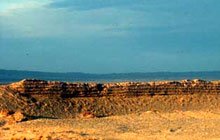 Compare this example of cultural intercourse and compromise with another of Dunhuang's famous sites – the remnants of the earliest sections of the Great Wall. This 16 foot high wall of stamped earth, reinforced with wood, appears as spectacularly random in the midst of the world's second-largest desert. Over two thousand years old, this sinuous fortification, as weathered and cracked as the gargantuan rock formations it purports to divide, now seems more a product of nature than of humanity. Even though the power and scale of the seemingly infinite desert mock the Great Wall's pretensions to mastery, it is an achievement for this human endeavor to have been constructed and have survived for so long in such a hostile environment.
Compare this example of cultural intercourse and compromise with another of Dunhuang's famous sites – the remnants of the earliest sections of the Great Wall. This 16 foot high wall of stamped earth, reinforced with wood, appears as spectacularly random in the midst of the world's second-largest desert. Over two thousand years old, this sinuous fortification, as weathered and cracked as the gargantuan rock formations it purports to divide, now seems more a product of nature than of humanity. Even though the power and scale of the seemingly infinite desert mock the Great Wall's pretensions to mastery, it is an achievement for this human endeavor to have been constructed and have survived for so long in such a hostile environment.
On the one hand, the Mogao Caves create a space for cultures to meet. On the other, the Great Wall was intended to keep cultures apart.
From its inception thousands of years ago, the Great Wall has been a touchstone for debate on how China should deal with her fierce neighbors. Opponents of the Great Wall claimed that peace could only be assured through economic, social and political engagement with China's borderland tribes. When this policy of engagement was preponderant, the borderlands were peaceful. However, at just these times, proponents of the Great Wall argued that Chinese prestige was suffering as a result of China's continual concessions to the warlike tribes, and thus the pendulum swung the other way.
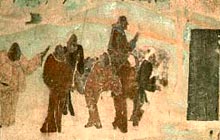 Let us leave the ancient remnants of this Great Wall to travel along the local trade route that led Chinese culture to clash for its first time with a foreign civilization. The Silk Road brought great economic and military benefits to China. The westward export of goods from China fostered terrific fortunes: silks, teas and jade products as well as such brilliant inventions as paper, gunpowder and the compass reaped unimaginable financial rewards. The eastward import of goods most importantly introduced the legendary horses of Central Asia's Ferghana valley; their speed and stamina giving China the military edge in the region. However, the benefits of this trade came at a cost, namely commercial and ideological exchange with alien peoples, societies and cultural values. The homegrown religions of Daoism and Confucianism were threatened by the eastward spread of Buddhism. Han Chinese were forced to deal with the growing military threat of Tibet and the semi-nomadic tribes of the Western regions. Meanwhile the rapid economic and territorial growth of the Chinese Empire was drawing an ever increasing diversity and number of peoples' and thought systems into its sphere of influence. There was a clear danger that this crucible of heterogeneous admixtures would so overheat as to blow the Chinese Empire asunder!
Let us leave the ancient remnants of this Great Wall to travel along the local trade route that led Chinese culture to clash for its first time with a foreign civilization. The Silk Road brought great economic and military benefits to China. The westward export of goods from China fostered terrific fortunes: silks, teas and jade products as well as such brilliant inventions as paper, gunpowder and the compass reaped unimaginable financial rewards. The eastward import of goods most importantly introduced the legendary horses of Central Asia's Ferghana valley; their speed and stamina giving China the military edge in the region. However, the benefits of this trade came at a cost, namely commercial and ideological exchange with alien peoples, societies and cultural values. The homegrown religions of Daoism and Confucianism were threatened by the eastward spread of Buddhism. Han Chinese were forced to deal with the growing military threat of Tibet and the semi-nomadic tribes of the Western regions. Meanwhile the rapid economic and territorial growth of the Chinese Empire was drawing an ever increasing diversity and number of peoples' and thought systems into its sphere of influence. There was a clear danger that this crucible of heterogeneous admixtures would so overheat as to blow the Chinese Empire asunder!
So, how did governors of Dunhuang, the wealthiest and most significant of the borderland areas on the Silk Road, deal with the challenge of managing so much diversity? To understand the factors of their successful strategy, you should firstly put yourself in the saddle of a traveler of the time.
The first time you, yourself, journey to Dunhuang, the closest you will probably come to the vicissitudes of the desert, will be in the flickering shadow of your airplane as it fleets across the pitiless expanses. However, not far from Dunhuang, at the Dunes of the Singing Sands, you can mount a camel and recreate the experience of traveling along the Silk Road two thousand years ago. Even when you are lulled into reverie by your proud-nosed camel's lolling sway, you will still feel the heat of the sun parching your skin. In your imagination, you might see yourself within a large caravan of traders. There may even be a protecting contingent of soldiers accompanying your group. However, it is early morning and the hum of the tall, shifting sands fills you with foreboding. You open your eyes to see the dunes rise out of the air before you; instantly you are dwarfed by the immensity of the desert. One foul sand storm is all that is needed for you to lose your group, your family and your bearings. You recall the stark warning of Fa Xian, that famous monk of the fourth century, who writes from this spot, "the only signs of a road are the skeletons of the dead. Wherever they lie, there lies the road to India." Though you have heard tell of brigands along the way, you now feel all too keenly that your greatest threat lies not from other people, but from nature itself.
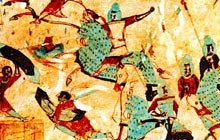 The perennial threat of the desert hung over every oasis town, inhabitant and traveler. This constant reminder of life's transience and death's arbitrariness acted as a break on any dispute; it added a broader dimension to life along the Silk Road. Although this factor naturally calmed social unrest, Dunhuang's governors did not need to rely on it. At any given moment, they could enforce their will through a forceful military presence. The threat of their strong garrison was softened however by conciliatory cultural policies. It is the syncretic give and take of this cultural policy of engagement that is exhibited in the murals of the Mogao Caves.
The perennial threat of the desert hung over every oasis town, inhabitant and traveler. This constant reminder of life's transience and death's arbitrariness acted as a break on any dispute; it added a broader dimension to life along the Silk Road. Although this factor naturally calmed social unrest, Dunhuang's governors did not need to rely on it. At any given moment, they could enforce their will through a forceful military presence. The threat of their strong garrison was softened however by conciliatory cultural policies. It is the syncretic give and take of this cultural policy of engagement that is exhibited in the murals of the Mogao Caves.
In the shadowy caves (take a torch with you), there is no apparent contradiction between the thousands of Buddhas painted on the lower walls and the Daoist symbols painted on the ceiling. Nor is there one between the Confucianist veneration of ancestors on one wall and a representation of the historic Buddha running away from his family on another. Instead of analytically challenging components of each others' belief systems, the artists have assimilated all aspects of the faiths in a rich mythological tapestry. What appears irrational to one person will surely seem inspiring to another – both will agree that the representations are dazzlingly rich and beautiful.
Hegel observed that we learn from history that we do not learn from history. As we enter an age which the historian Samuel Huntingdon has characterized as being afflicted with the clash of competing civilizations, we do well to remember that civilizations have clashed many times before. They did so along the Silk Road approximately two thousand years ago, and the principle fruit of this encounter were hundreds of cave paintings of spell-binding harmony and beauty.
First published March 2003 in Culturaltravels.com under the title "A Study In Harmony".
A Review of "Genghis Khan" by James Chambers
Reviewed by Guy Rubin
"Seven hundred years ago a man almost conquered the earth. He made himself master of half the known world, and inspired mankind with a fear that lasted for generations. In the course of his life he was given many names – Mighty Manslayer, Scourge of God, Perfect Warrior. He is better known to us as Genghis Khan."
So begins Harold Lamb's 1928 "Genghis Khan" which, more than seventy years after its publication, remains the best-selling history on the Great Khan. James Chambers' new text is unlikely to unseat Lamb's for the top spot. Not that his "Genghis Khan" is anything but a lucidly written and intelligently organised work: It, like Leo De Hartog's new history ("Genghis Khan: Conqueror of the World", 1999, IB Tauris and Company), vies for a legitimate niche in the book market. For, with the exception of JJ Saunders' 1971 monograph, "The History of the Mongol Conquests", there is no concise account of the rise to world mastery of this nomadic shepherd. Most modern histories of the Mongol Horde are every page as exhaustive as the first Persian chronicles.
And yet one cannot help feeling that with this publication, the marketers have missed their mark. For readers are drawn to the history of Genghis Khan more by a spirit for romance than a dry thirst for fact – witness the enduring popularity of Harold Lamb's out of date but evocative text. Though academic probity inevitably harnessed Lamb's imaginative foray into twelfth century Mongolia, this well-respected British historian clearly sought to identify with Genghis Khan rather than judge him. Lamb's preference for empathy over analysis has maintained the popularity of his history. In so doing, he raised his work to the mythological stature of its demanding subject matter.
It is next to impossible for any short, popular history, whether by James Chambers or Leo De Hartog, to come to terms with the complexities of the tale of Temujin, Genghis Khan – Prince of all Conquerors. Without extensive background information, galloping the reader onto the hostile, Mongolian steppes, any biographical work – historical or fictive – is doomed to be as revealing about Genghis Khan as an arrow is of war. It will do no justice to this Nietzchean figure, who by force of personality united the internecine Mongolian tribes, transformed them into a disciplined fighting force, and built – step by step – the largest ever land-based empire, with a legacy lasting in Moghul India into the eighteenth century.
It is only in approaching the myth of Genghis Khan, that one may glimpse the wounded and sometimes savage human being beneath. Picture this for example: You are a child; your father has been murdered; your bereaved mother and brothers are scratching the barren steppes for food. And tomorrow? Your captors have scheduled it for your execution.
Few people have the misfortune to suffer such tribulations. Fewer still possess the character to defy them. It is a quality of Temujin's greatness that he not only overcame them, but that he learnt from them. It took such a man to raise a disorganised rabble to the heights of the Caesars. That man, understandably, has been mythologised; to some he is a God; to others, His curse.
Either way, you'll not risk meeting him in James Chamber's 128 page history. All you'll find here is a tidy introduction to the consensus history. And like most histories, it does not address the enigmas at the root of Temujin's life: Why, for example, did King Toghril first lend this indigent nomad a 20,000-strong army? Or what happened in the relationship between Jamuga and Temujin to turn them from blood brothers – and perhaps lovers – to mortal enemies?
"The Secret History of the Mongols" – the ultimate reference for such matters – offers elliptic and unconvincing explanations. Ironically, we must turn to fiction for a compelling, if unsubstantiated, alternative. "The Earth is the Lord's" Taylor Caldwell's 1940 novel, though emonizing its hero, makes a fascinating contribution to such imponderables. By tracing Temujin's journey from the terrible crucible of his childhood to his glorious unification of the Mongol tribes, Caldwell provides an intellectually refreshing and unsettlingly credible insight into the figures and issues at the center of this historical drama.
Thus, as readers, we are left with the embarrassing admission that the most popular history and historical novel on Genghis Khan, were both written more than fifty years ago. Though this bears no reflection on scholars of the calibre of Central Asianists like Morgan or Ratchnevsky, popularizing writers such as James Chambers should take note. By limiting their scope to one pre-defined by a marketing guru, they are unlikely to win readers' hearts – especially for so romantic a figure as Temujin, "Mighty Manslayer, Scourge of God, Perfect Warrior. better known to us as Genghis Khan."
June 2000, Chinanow.com